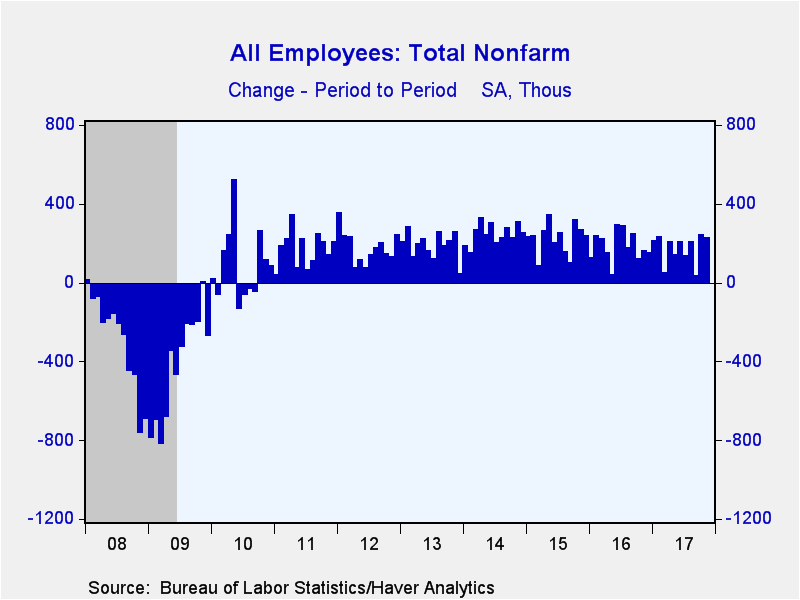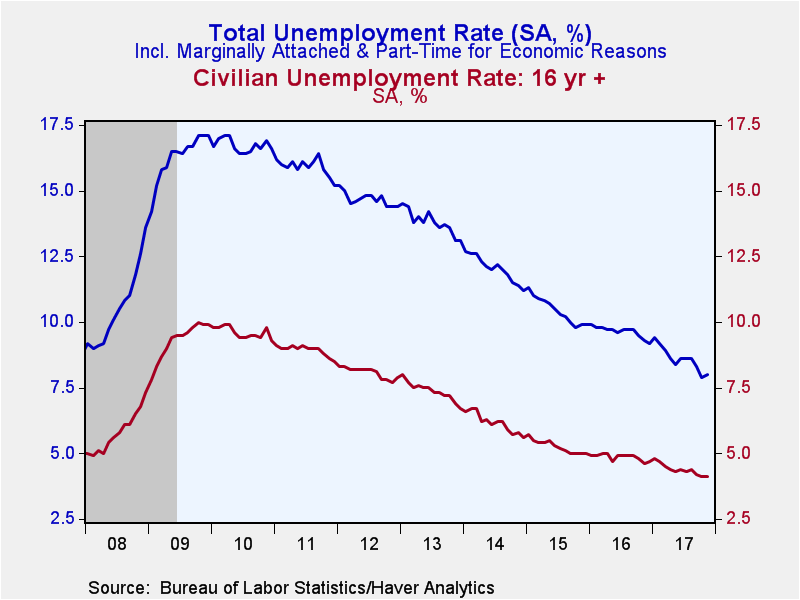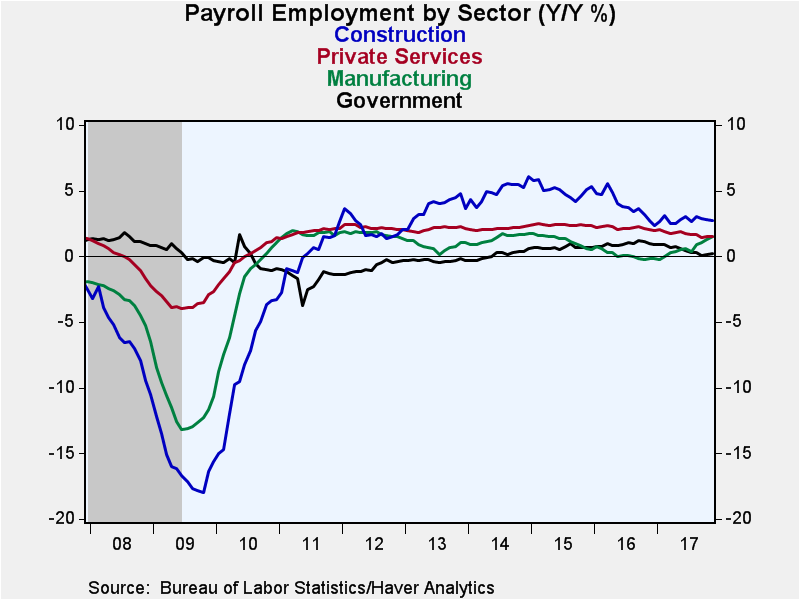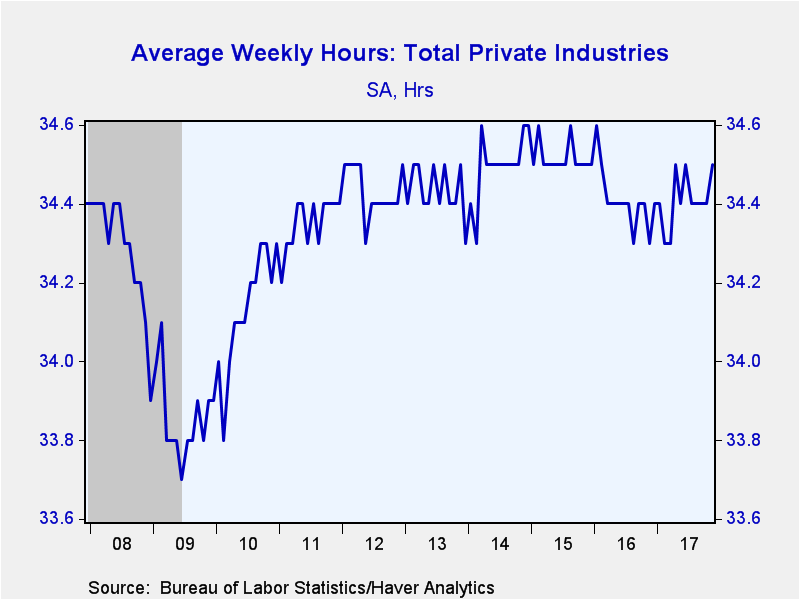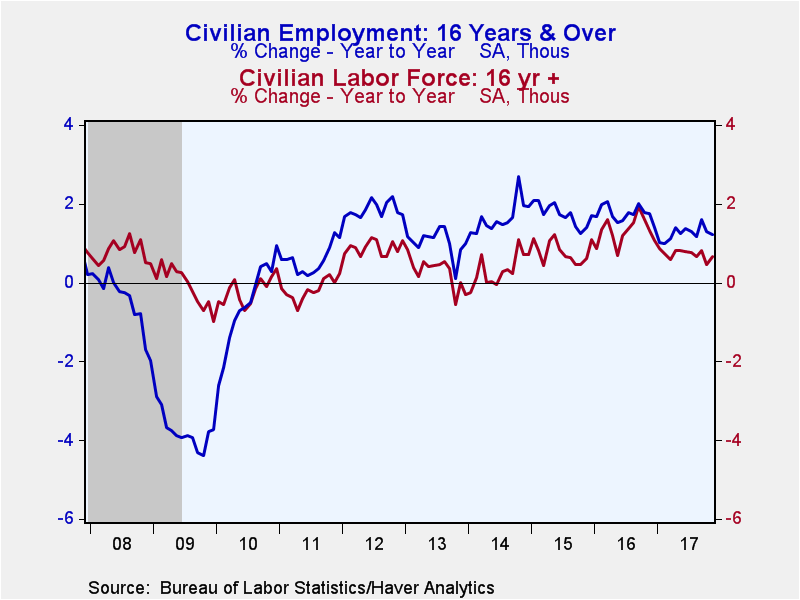 Global| Dec 08 2017
Global| Dec 08 2017U.S. Payrolls Exhibit Steady Growth; Jobless Rate Is Unchanged & Wages Inch Higher
by:Tom Moeller
|in:Economy in Brief
Summary
The labor market remained on a firm footing last month. Nonfarm payrolls increased 228,000 (1.4% y/y) during November following a 244,000 October increase. Together these two figures were revised up by 3,000. A 198,000 increase in [...]
The labor market remained on a firm footing last month. Nonfarm payrolls increased 228,000 (1.4% y/y) during November following a 244,000 October increase. Together these two figures were revised up by 3,000. A 198,000 increase in payrolls had been expected in the Action Economics Forecast Survey. The unemployment rate held steady at 4.1%, as expected. The overall unemployment rate, including the marginally-attached and those working part-time for economic reasons, ticked higher to 8.0% from 7.9%, but remained down versus 9.3% one year earlier. Average hourly earnings increased 0.2% (2.5% y/y) after falling 0.1% in October. A 0.3% gain had been expected.
From the payroll survey, last month's rise in employment was broadly distributed. The number of factory sector jobs increased 31,000 (1.5% y/y), the largest increase in three months. Construction sector employment gained 24,000 (2.8% y/y), also a three-month high. Mining sector jobs improved 5,200 (10.1% y/y), with notable strength in support activities.
Within the private service sector, education & health service hiring increased 54,000 (2.0% y/y), the strongest increase in nine months. Professional & business service sector jobs rose 46,000 (2.7% y/y), including an 18,300 increase (4.0% y/y) in temporary help jobs. Trade, transportation & utilities employment gained 32,000 (0.7% y/y), following a 14,000 increase. Leisure & hospitality hiring rose a reduced 14,000 (1.8% y/y) after a 104,000 jump in the wake of storm damage. Financial sector employment improved a modest 8,000 (1.8% y/y). Information sector employment was off 4,000 (-2.2% y/y), and has been falling since the middle of last year.
In the government sector, a 7,000 increase (0.1% y/y) in jobs reflected a 9,000 rise (0.4% y/y) in local government. State government employment rose 1,000 (-0.6% y/y), the first increase since July. Federal government employment declined 3,000 and was unchanged y/y.
The breadth of employment increases spanned 63.0% of industries, up from 51.5% twelve months earlier. In the factory sector, increased hiring was experienced in 59% of industries, up from a low of 37.8% in March of last year.
The length of the average workweek rose to 34.5 hours after four straight months at 34.4 hours. The factory sector workweek of 40.9 hours was higher than the March low of 40.6 hours. Construction sector hours have been fairly steady near 39.1 since early last year. Financial activity hours rose to 37.6 from 37.3 early this year. Information sector hours eased to 36.1 from the December 2013 high of 36.8. Education & health sector hours have been steady since mid-2016 at 32.9, while leisure & hospitality hours of 26.1 were below the 2015 high of 26.4.
 Average hourly earnings increased 0.2% with the 2.5% y/y
increase well below the December 2016 peak of 2.9%. The slowdown has been
pronounced in the factory sector, moving to 1.9% y/y from 3.5% in June of last
year. Leisure & hospitality earnings growth decelerated to 3.6% y/y.
Professional & business services earnings growth has been steady at 2.5%,
but financial sector earnings growth picked up to 3.4% y/y.
Average hourly earnings increased 0.2% with the 2.5% y/y
increase well below the December 2016 peak of 2.9%. The slowdown has been
pronounced in the factory sector, moving to 1.9% y/y from 3.5% in June of last
year. Leisure & hospitality earnings growth decelerated to 3.6% y/y.
Professional & business services earnings growth has been steady at 2.5%,
but financial sector earnings growth picked up to 3.4% y/y.
From the household employment survey, the steady 4.1% unemployment rate reflected a 57,000 increase (1.2% y/y) in employment and a 148,000 rise (0.7% y/y) in the labor force. The average duration of unemployment declined to 25.4 weeks from 39.4 weeks in 2011.
The labor force participation rate held steady at 62.7%. Notable has been the differing patterns of participation between men & women. For men aged 25 to 54 years old, the rate has been steady near 88.5% since early last year, up from a 2014 low of 88.2%. In contrast, the rate for women aged 25 to 54 surged to 75.3% last month from a low of 73.3% in March of 2015. That was the highest level since 2008, while the men's rate is down from roughly 91% over the same period.
By educational attainment, the unemployment rate for individuals with less than a high school diploma fell to an expansion low of 5.2%. For high school graduates but no college, the rate held steady at the expansion low of 4.3%. For individuals with less than a bachelors degree, the rate was 3.6%, while those with a bachelor's degree or higher were 2.1% unemployed.
The teenage unemployment rate jumped to 15.9% from an expansion low of 12.9% in June. For individuals aged 20-24 years old, the rate held steady m/m at 7.2%. For those aged 25-54 years old, it was steady at 3.4% and individuals over age 55 were 3.1% jobless.
The labor market data are contained in Haver's USECON database. Detailed figures are in the EMPL and LABOR databases. The expectations figure is in the AS1REPNA database.
| Employment: (SA, M/M Change, 000s) | Nov | Oct | Sep | Nov Y/Y | 2016 | 2015 | 2014 |
|---|---|---|---|---|---|---|---|
| Payroll Employment | 228 | 244 | 38 | 1.4% | 1.7% | 2.1% | 1.9% |
| Previous Estimate | -- | 261 | 18 | -- | -- | -- | -- |
| Manufacturing | 31 | 23 | 9 | 1.5 | 0.1 | 1.2 | 1.4 |
| Construction | 24 | 10 | 13 | 2.8 | 3.9 | 5.0 | 5.0 |
| Private Service-Producing | 159 | 213 | 24 | 1.6 | 2.1 | 2.4 | 2.1 |
| Government | 7 | -3 | -12 | 0.1 | 0.9 | 0.7 | 0.1 |
| Average Weekly Hours - Private Sector | 34.5 | 34.4 | 34.4 | 34.3 | 34.4 | 34.5 | 34.5 |
| Private Sector Average Hourly Earnings (%) | 0.2 | -0.1 | 0.4 | 2.5 | 2.5 | 2.1 | 2.3 |
| Unemployment Rate (%) | 4.1 | 4.1 | 4.2 | 4.6 | 4.8 | 5.3 | 6.2 |
Tom Moeller
AuthorMore in Author Profile »Prior to joining Haver Analytics in 2000, Mr. Moeller worked as the Economist at Chancellor Capital Management from 1985 to 1999. There, he developed comprehensive economic forecasts and interpreted economic data for equity and fixed income portfolio managers. Also at Chancellor, Mr. Moeller worked as an equity analyst and was responsible for researching and rating companies in the economically sensitive automobile and housing industries for investment in Chancellor’s equity portfolio. Prior to joining Chancellor, Mr. Moeller was an Economist at Citibank from 1979 to 1984. He also analyzed pricing behavior in the metals industry for the Council on Wage and Price Stability in Washington, D.C. In 1999, Mr. Moeller received the award for most accurate forecast from the Forecasters' Club of New York. From 1990 to 1992 he was President of the New York Association for Business Economists. Mr. Moeller earned an M.B.A. in Finance from Fordham University, where he graduated in 1987. He holds a Bachelor of Arts in Economics from George Washington University.


